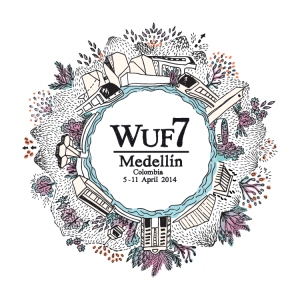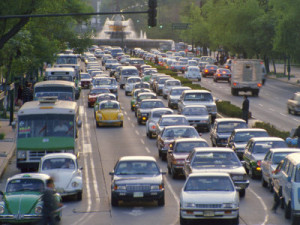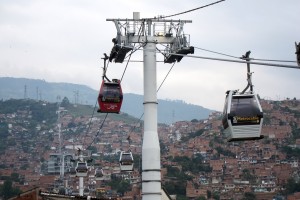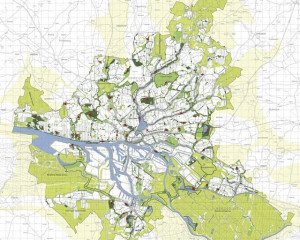The upcoming World Urban Forum, the largest, most diverse conference dedicated to cities, will address how urban design can create equitable, sustainable and livable cities for all residents.
In preparation for the event, which opened Saturday in Medellin, Colombia, and runs through Friday, some of the leaders of the World Resources Institute and EMBARQ, its sustainable transport and urban development initiative, discussed the challenges cities are facing and how they are overcoming them.
Cities bring a wealth of challenges, according to Manish Bapna, executive vice president of WRI, which has offices based in China, India, Brazil and the United States. Poverty is rampant and the urban poor often lack access to basic services, such as public transportation. Although cities currently account for 80 percent of the global GDP, they are also responsible for 75 percent of greenhouse gas emissions, and 1.3 million people die prematurely due to urban air pollution every year.
“The spatial layout of a city has such a strong bearing on whether or not people remain segregated from public services,” Bapna said. “It is crucial to get the design right at the outset.”
EMBARQ, which has offices in Washington, D.C., Mexico, Brazil, Turkey, China and India, works with governments around the world to develop better access (mobility) and urban design by creating examples and working with legislators to improve finance and policy to make the projects possible.
According to EMBARQ, cities already house half of the world’s population. Over the next 30 years, they will gain an additional 75 million residents each year. By 2050, the urban population is estimated to stand at 5.2 billion. According to the World Health Organization, 70 percent of traffic crashes involve vulnerable road users, namely pedestrians. Most of them are low or middle income and many are young or elderly.
“Cities are truly at a crossroads,” Bapna said. “Are they going to be a part of the problem…, or are they going to be part of the solution?”
Bapna noted the importance of developing a compact city. He said cities can either be compact, livable and integrated, or they can be sprawling. The latter create greater divisions between groups, lead to more unsustainable approaches to transportation, and poorer access to public services.
Mexico was one example. Between 1980 and 2010 the country’s urban population doubled, but the urban land area increased six-fold, leaving roughly 200,000 acres unoccupied, according to Adriana Lobo, director of EMBARQ Mexico. New buildings were instead constructed on the outskirts of the cities.
As a result, low-income families spend 25 of their income on transportation and Mexico City residents can lose upwards of five years of their lives waiting in traffic. In the capital alone, this adds up to 3.3 million man-hours lost due to traffic congestion every day.
“We are working to reorient urban reform around people and not cars,” said Robin King, director of urban development and accessibility for EMBARQ. She also said they seek to bring the significant advantages of transportation to all people, so that those who cannot afford a vehicle will discover they do not need to use one.
Urban reform seeks to create more compact cities with good public spaces and adequate pedestrian and cyclist infrastructure. Progress is being made according to Lobo. For the first time, sustainable mobility is mentioned in the Mexican national development plan.
“In order for cities to better address equality and sustainability, we need to see some fairly fundamental reforms in how cities are able to raise money and how they are governed to create greater accountability to the poor and to the people that live within that city,” Bapna said.
Bapna also noted how cities have the tendency to fall into old habits.
“Despite significant efforts, a lot of the old models of urban infrastructure continue to persist,” Bapna said. However, he did say there are many cities using innovative new models.
According to King, some Scandinavian countries are good models of urban development, and in particular, Copenhagen, which exhibited how to have a network of non-motorized transport opportunities.
Dario Hidalgo, director of research and practice for EMBARQ, named New York City as an example of equitable, sustainable design. With an increased emphasis on pedestrian and bicycle mobility and improvements to public transit, the Big Apple has been able to transform itself into the “greatest and greenest city in the world right now.”
Belo Horizonte, Brazil, introduced its first BRT system (MOVE) last month. MOVE operates 18 buses, each capable of carrying 140 passengers. It is projected to transport 700,000 passengers daily by the end of 2014.
“The BRT in Belo Horizonte is one of the most successful,” Lobo said. Since its inception, the commute is now five times faster, according to Lobo. EMBARQ is also measuring the particulate matter and nitrogen dioxide in the city to understand how much the BRT system is changing the life conditions of residents. Brazil has recently invested $48 billion towards BRT corridors, and train and subway projects.
Medellin, location of this year’s World Urban Forum, was also mentioned as a role model.
“What happened in Medellin was a renaissance,” Hidalgo said. He explained how its government focused on the very low income and violent areas of the city and provided better mobility with the introduction of cable cars, metro and BRT systems. They also improved the conditions to allow people to walk to these locations, and they provided the services directly where the people needed it.
Then there is the case of Hamburg, Germany. In what Lobo calls “one of the most ambitious examples of trying to green a city,” Hamburg is attempting to become car-free within the next 20 years. With a population of roughly 1.8 million, this is no small feat.
“The officials feel that a car does not serve a function that walking, biking and taking public transport cannot,” Lobo said.




